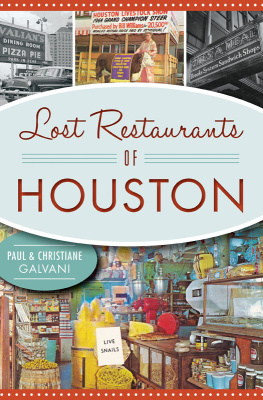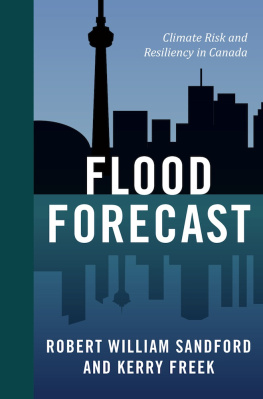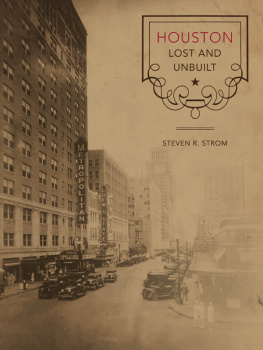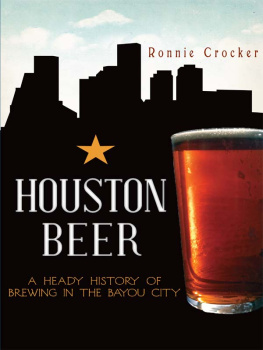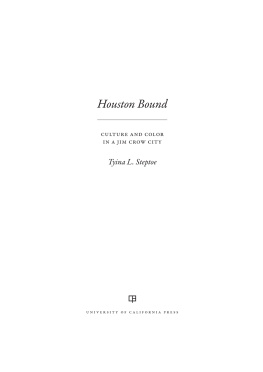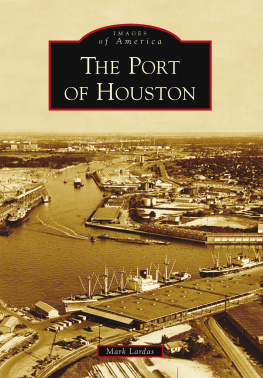
More City Than Water
A HOUSTON FLOOD ATLAS
EDITED BY
Lacy M. Johnson and Cheryl Beckett

UNIVERSITY OF TEXAS PRESS
AUSTIN
Support for this book comes from an endowment for environmental studies made possible by generous contributions from
Richard C. Bartlett, Susan Aspinall Block, and the National
Endowment for the Humanities.
Copyright 2022 by Lacy M. Johnson
All rights reserved
First edition, 2022
Requests for permission to reproduce material from this work should be sent to:
Permissions
University of Texas Press
P.O. Box 7819
Austin, TX 78713-7819
utpress.utexas.edu/rp-form
Library of Congress Cataloging-in-Publication Data
Names: Johnson, Lacy M., 1978 editor. | Beckett, Cheryl, editor.
Title: More city than water : a Houston flood atlas / edited by Lacy M. Johnson, Cheryl Beckett.
Description: First edition. | Austin : University of Texas Press, 2022.
Identifiers: LCCN 2021040781
ISBN 978-1-4773-2500-1 (cloth)
ISBN 978-1-4773-2566-7 (PDF)
ISBN 978-1-4773-2567-4 (ePub)
Subjects: LCSH: FloodsTexasHouston. | FloodsSocial aspectsTexasHouston. | FloodsEnvironmental aspectsTexasHouston. | FloodsPolitical aspectsTexasHouston. | FloodsTexasHoustonHistory. | FloodsTexasHoustonMaps. | LCGFT: Essays.
Classification: LCC GB1399.4.T4 M67 2022 | DDC 303.48/5dc23/eng/20211020
LC record available at https://lccn.loc.gov/2021040781
doi:10.7560/325001
For Houston
with love
Contents
LACY M. JOHNSON
SONIA HAMER
AIMEE VONBOKEL WITH TANYA DEBOSE AND ALEXANDRIA PARSON
ROY SCRANTON
MARTHA SERPAS
ELAINE SHEN
CHERYL BECKETT
LACY M. JOHNSON
SONIA DEL HIERRO
LYRIC EVANS-HUNTER
BRUNO ROS
BRYAN WASHINGTON
DANA KROOS
ALLYN WEST
LACY M. JOHNSON
DANIEL PEA
SUSAN ROGERS
BEN HIRSCH
DOMINIC BOYER
GENEVA VEST
LAURA AUGUST
CYMENE HOWE
LACY M. JOHNSON
MORE CITY THAN WATER

INTRODUCTION
More City Than Water
Lacy M. Johnson
Theres a light pole on my street, a few houses down from mine, where one of my neighbors has painted a rainbow stripe, about as high as my chest, to mark the high-waterpoint reached during Hurricane Harvey in 2017. The paint has chipped a little in the several years since the storm. The houses in our neighborhood have been repaired; the dumpstersfilled with moldy sheetrock and furniture, carpet, and ruined family albumshave all been hauled away.
Hurricane Harvey made landfall on Friday, August 25, in Rockport, Texas, virtually destroying the entire town, before heading northeast along the Gulf Coast. The storm arrived in southwest Houston early Saturday and stalled over the city for five days, dropping as much as 61 inches of rain in some placesat that time it was the single greatest rainfall event in North America in recorded history. Each of the eleven bayous in the city left its banks and entered the surrounding neighborhoods. But now, more than three years later, it is still unclear what percentage of people have lost or had damage to their homes. Ive heard a third of the people. Ive heard over 100,000 homes. Or 200,000 homes. In some places in the city, some people still havent even begun the process of reconstruction. Their FEMA claims have been denied; their applications for a buyout have been denied. They called the disaster hotline for assistance and found no one who spoke their language.
In my neighborhood in west Houston, the worst of the flooding arrived when the Army Corps of Engineers decided to open the dams at Barker and Addicks Reservoirs to prevent what they were calling, somewhat euphemistically, catastrophic failure and uncontrolled release. Downstream from the dams, a mile from Buffalo Bayou, my family and our neighbors had gone to bed grateful that the storm was finally beginning to move off to the east. But when we woke up in the morning, the bayou had become a river, over a mile wide, raging through the streets past our front door. At a press conference, men in official-looking uniforms told those of us who watched the livestream at home that the water would continue to rise, but that no one knew how much. Maybe one foot. Maybe three feet. Outside, the water bubbled up from storm drains, out of sewers, smelled of the rank contagion of human and industrial waste. One neighbor, a surveyor, got out his equipment to see how much more water the street could take before the flooding reached the houses. None of us could take much more.
Like thousands of others, my family chose to evacuate, carefully placing all our furniture on blocks before leaving our home. Helicopters circled overhead, and US Coast Guard members rode airboats along the rivers of our streets as we trudged through sewage to the end of the block, where we left the neighborhood and entered a militarized zone. Soldiers helped my elderly neighbors off high-water military vehicles while emergency medical responders administered oxygen and first aid under plastic tents. My family eventually found refuge at our friends home across town, in a neighborhood where a few branches had fallen into yards here and there, but all the streets were dry. Buses were running. Pizza could be delivered to your door.
For weeks afterward, many people helped in the ways we knew how: by volunteering our time or labor; by organizing food for the thousands of evacuees; by collecting donations for families and schools in need. I heard dozens of stories of everyday heroism, and these storiesheard and repeated, over and overhave become the official stories of the storm: a story of sacrifice and resilience, of working together for the common good. We repeat these stories because we like what they say about us as a community, as peoplebut these stories arent complete, and they are only partially true.
I also heard the story of a man whose house, built up on a raised foundation above the street level, did not flood at the end of a street where every other house went underwater. The day after the flood receded, when his neighbors were allowed back to their homes, he sat on his porch with a gun over his knee and aimed it at anyone who tried to park in front of his drivewayflaunting his dry privilege, as well as the coldness of his heart. I heard, too, the story of a single mother in the predominantly African American neighborhood of Houston Gardens in northeast Houston, who was living in a tent in her yard because she had been denied assistance by FEMA. She was trying to muck out the house herself, to make it livable again, before volunteers finally arrived to help. But when a friends home flooded on the other side of town, in Meyerland, which is predominantly affluent and white, her family received help from FEMA and insurance adjusters, and within days, a team of contract laborers were swinging hammers and putting her house, and life, back into place. These stories, and the inequality they represent, also tell us who we are as a community, as people.
My proximity to flooding during Harvey has made me think a lot about flooding over the past several years, though for a long time I almost never thought about flooding at all. When I moved to Houston in 2004 with my then boyfriend, we rented a tiny apartment on the second floor of a duplex in Montrose and shared only one car between us. We didnt have a television at that time and had little access to the news. A few times each June through November, during Houstons annual hurricane and heavy rain season, my mom would call from Missouri to ask whether our house was flooded. Houston is all over the news, she would say, watching footage of flooded underpasses and high-water rescues. Our neighborhood was on high ground, I explained; our street was dry except for a few puddles. I knew that a few blocks from our home, Buffalo Bayou had probably left its banks to fill Eleanor Tinsley Park. Soon it would drain, and the flooding would disappear, and I would forget the city had ever flooded at all.



